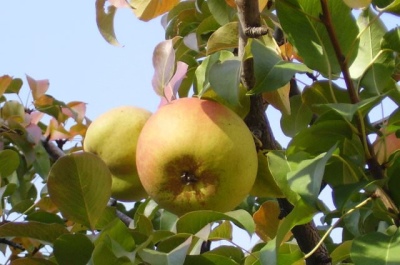
- Authors: I. V. Michurin, Federal State Budgetary Scientific Institution "Federal Scientific Center named after I. V. Michurin"
- Appeared when crossing: wild Ussuri pear x Bere Royal (Bere Dil)
- Year of approval: 1947
- Fruit weight, g: 90-100
- Ripening terms: winter
- Fruit picking time: at the end of September
- Appointment: universal
- Growth type: medium height
- Yield: high
- Transportability: high
The varieties developed in the middle of the twentieth century are still relevant to this day. Bere winter Michurina is a good example of this. This pear gives a decent result, but its features should be studied to rule out errors and problems.
Breeding history
This sort of pear belongs to the authorship of the legendary Michurin himself. The breeder conducted his work by crossing the Bere Royal with the wild Ussuri pear. The official registration of the culture took place in 1947.
Description of the variety
The culture has versatile horticultural applications. Medium-sized trees are crowned with a spreading crown in the form of a wide pyramid. Other features:
geniculate shoots are slightly curved, painted in a light green tone;
ovoid yellowish-green foliage with a slight grayish tint;
weak pubescence of shoots.
Fruit characteristics
Medium-sized fruits of this pear weigh 90-100 g. They have the usual pear-shaped shape, slightly shortened. Visual asymmetry is occasionally noted. The dominant light green color is typical. A cloudy blush is formed as a cover color.
But these signs appear only at the moment of removable ripeness. If the fruits of Bere winter Michurin have already reached the necessary consumer conditions, then they turn yellow and acquire a pronounced blush. The slightly rough skin includes large gray subcutaneous dots. The peduncle is thick and long.
Taste qualities
The white pulp of this pear has a sour-tart taste. He is given a mediocre tasting score, or rather, from 4.64 to 4.75 points. The share of sugars reaches 10.5%. The pulp is quite juicy. But at the same time, its roughness is also noted.
Ripening and fruiting
Already from the name it follows that this is one of the so-called winter pears. Harvesting time comes in the last decade of September. Fruits will appear at the age of 4-6 years. What is noteworthy is that the harvested pears can be transported easily and without problems.

Yield
The variety is considered very prolific even by modern standards. The collection for 1 tree ranges from 80 to 120 kg. Specific indicators are equally dependent on the weather and agrotechnical measures.
Landing
It is most expedient to cultivate such a pear in the Central Black Earth Region and on the Lower Volga. It is these areas that are officially zoned for her. With caution, you can try Bere winter Michurin in places with a milder and more comfortable climate. In any case, it is inappropriate to choose areas subject to blowing winds. It is worth remembering that this culture is critically dependent on sunlight.


Growing and care
The variety belongs to the self-fertile group. Therefore, you will not need to plant pollinating trees next to it. In general, the plant is resistant to diseases. Its immunity to scab and fungal infections is especially great. Maximum attention should be paid to drainage.
The root complex of Bere winter Michurina does not tolerate excessive moisture at all. Therefore, a high-quality drainage layer in a deep pit is required. A hole is dug 10 days before planting so that it settles. The tree itself is planted in soil composed of:
sand;
humus;
superphosphate.
The root collar should be raised above the surface by at least 6 cm. The area near the trunk is watered as abundantly as possible. For mulching, take sawdust or dry humus. For this variety, stagnation of moisture in the ground is fatal, therefore it is impossible to overdo it with watering. After each watering, you need to loosen the soil. In addition to better aeration, this will also allow you to cope with weeds.
Preventive treatments to protect against infections and pests are carried out in the spring. The best time for them is April and May. In summer and early autumn, it is advisable to duplicate such manipulations for the sake of greater effect. The first feeding is carried out one year after planting. Pruning long and degraded branches is recommended in early spring.




Like any other fruit trees, the pear needs protection from various diseases and pests. When planting a pear on your site, you need to know in advance what diseases you should beware of. To successfully carry out the struggle, it is necessary first to correctly identify the cause of the problem. It is important to distinguish signs of disease from manifestations of the presence of insects, mites, caterpillars and other types of pests.





































































